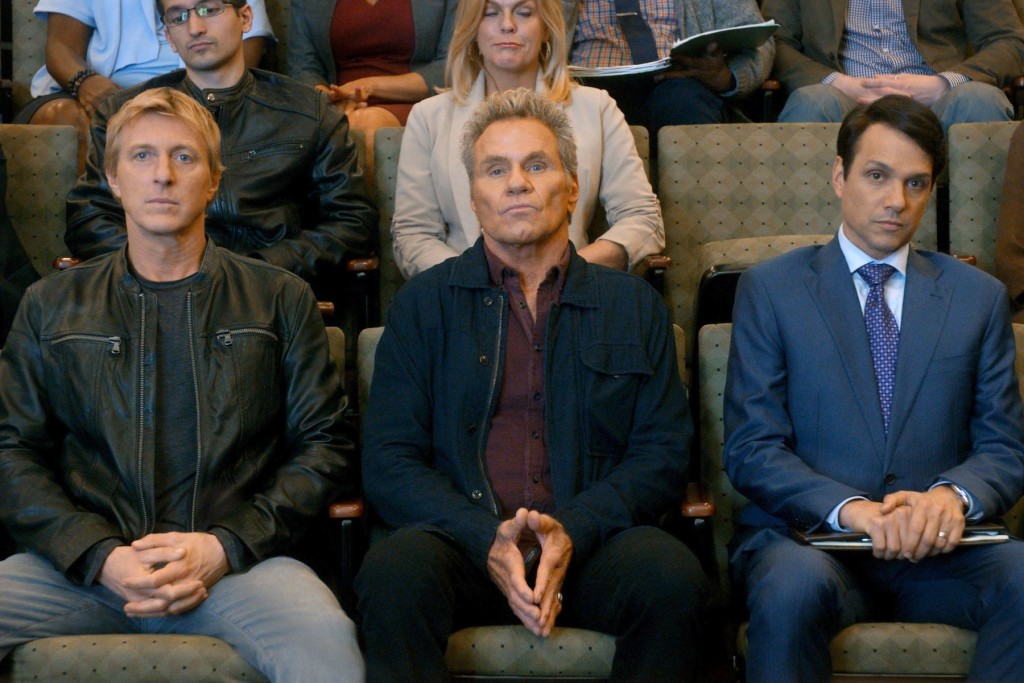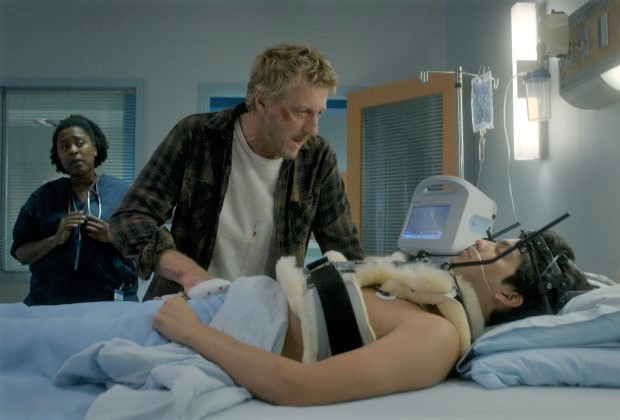“Carson,” some of you ask. “Why is it you like Cobra Kai so much? It barely adheres to the rules you preach and it’s one of the cheesiest shows on television!” I will agree with you on the second point. But the first point I’m going to push back on. Sure, Cobra Kai isn’t a university course in screenwriting awesomeness. But it does a lot of things right, which is why myself and so many other people are obsessed with it. So today, I’m going to share ten screenwriting lessons to take away from this season of Cobra Kai!
Goals, Goals, and more Goals! – Looking out at the landscape of a TV series can be daunting. 40-60 pages per episode. 10 episodes per season. 5-7 seasons. That can be as many as 4200 pages. How do you fill up all that time? There isn’t any one way. But goals help a lot. You set a goal for the key characters. They go off and either succeed or fail at that goal. And then you replace it with a new goal. For example, the season starts off with Johnny’s son, Robby, running away after putting Miguel in a coma during a fight. So Johnny and Daniel LaRusso go looking for him. That’s their goal. To find him. And when that goal is completed, their paths diverge and they each receive a new goal. Johnny tries to help hospital-bound Miguel walk again. And when Daniel’s car dealership is in danger of being bought by a Japanese company, Daniel heads to Japan to convince the company not to buy. TV character goals do not need to be wrapped up in a single episode. Depending on how big/important the goal is, it can last multiple episodes. Daniel’s trip to Japan lasts two episodes, for example. So whenever your TV show feels like it’s wandering, just add goals!
“You’ve got three minutes.” – It’s one of the oldest tricks in the book but it works like a charm. There’s something about a stated time limit in a scene that increases its intensity. Usually, when we talk about “urgency,” we do so in the context of the entire script. We add urgency (the “U” in “GSU”) to the hero’s journey. But you can do this in individual scenes as well. In a mid-season scene, Kreese (the big bad villain) approaches Johnny (the anti-hero) at a diner. Kreese wants to talk. Johnny doesn’t. Then a cop comes in behind Kreese, leans over the diner counter, and orders a sandwich to go. The cook says, “It’ll be ready in three minutes.” Johnny turns to Kreese. “You’ve got three minutes,” he says. And Kreese makes his case. This isn’t even an elegant way of using the rule. But the point is, it works. It gives the scene form and urgency. Contrast this with 75% of the scenes I read, which feel rudderless and never-ending. You can’t use this trick all the time or the reader picks up on it. But if you’re struggling with a scene, try it out. My guess is it will add a spark.
We’re going to need a bigger villain – Villains can often come off as one-dimensional. Mean for mean’s sake. And while in feature films, you’re often locked into that simplicity, you have more leniency in television, which has more time. Johnny started off as a villain in this franchise. And he occasionally dips back into that villainous role. But one of reasons we still root for Johnny is because there’s a bigger villain – Kreese. Kreese being cruel to Johnny makes Johnny sympathetic. This also happens with Hawk (the kid with the mohawk). Hawk is a big mean jerk and Kreese’s number 1 student. But then Kreese brings in new students, including a bigger meaner jerkier dude who always picks on Hawk at school. All of a sudden, Hawk doesn’t seem so bad. The act of bullying creates sympathy for the bullied party. Which is why, when you need to create sympathy for villains and anti-heroes, you just add a bigger villain.
Flip the Mentor script – In many movie and TV team-ups, there’s a mentor relationship. You have the older wiser mentor helping the younger inexperienced hero. But if you want to have some fun, especially in TV, you want the hero to occasionally teach the mentor. In Cobra Kai, Johnny is Miguel’s mentor. He helps him with karate and as well as regain his skills after his accident. But in episode 6, the technology-challenged Johnny is faced with a Facebook message from an old flame. Johnny’s first instinct is to write his life story back to her. But it’s Miguel who informs him that the move is suicidal, then helps Johnny write a proper response as well as improve his social media market value so he’ll look better for the girl.
Never use flashbacks… except in television! – You know how I feel about flashbacks. I hate them. However, with the extended length of a TV series (compared to a feature), flashbacks are more acceptable. But there’s a caveat to that. A flashback should never be used solely for exposition. It should be dramatic and entertaining in its own right. Kreese gets a lot of flashbacks in this season. The first of those shows him working at a restaurant as a teenager. The mistake would’ve been to have Kreese sitting with his high school sweetheart telling her all the things he wanted to do with his life (I can’t tell you how many times I’ve read a version of that scene). That’s dramatically uninteresting and the definition of straight exposition. Instead, they build the scene around a jock a-hole and his buddy giving Kreese a hard time (another “We’re going to need a bigger villain” moment!). The scene is entertaining in its own right due to the constant tension and conflict between Kreese and the jock. In the meantime, without even realizing it, we’re leaning about Kreese’s past. That’s how you do flashbacks.
Imply rather than tell – Miguel, our young hero who’s stuck in a hospital bed after waking up from his coma, can’t feel his legs. Now, sure, you can have a doctor come in and inform Miguel that, he’s sorry, but Miguel will never be able to walk again. But that’s “telling.” It’s more interesting if you “imply.” Miguel and his mother are talking. The doctor comes in. He does a couple of tests on Miguel’s legs. Then, the mother follows him out of the room, and Miguel sees them talking through the window. Whatever the doctor is saying is clearly devastating to the mother. That’s when we know, without any characters telling us, that Miguel won’t walk again.
Money makes the world (and storytelling) go round – Embrace money problems. It’s one of the best ways to motivate characters. Miguel’s surgery to fix his legs is going to cost a fortune. Johnny’s out of a job and running out of money for rent. Tory (one of the villains) is responsible for keeping a roof over her family’s head since her single mom is sick with cancer. The more people need money, the more desperate they get. And that’s where the drama comes from. Arguably the greatest TV show ever, Breaking Bad, is about a guy who has to make several million dollars before he dies of cancer to leave for his family.
Character Contrast for the win! – You should actively force your characters into places they don’t fit into. The rough-around-the-edges Johnny Lawrence meeting a couple of degenerates in a prison yard lacks contrast and therefore isn’t memorable. Meanwhile, a couple of Johnny’s funnier scenes occur when he goes to an upscale wellness center to visit his ex-wife. Or when he barges in on his old high school buddy turned priest while he’s giving a sermon. These scenes are both fun to write and fun to watch.
More characters means more potent scenes – Cobra Kai has a HUGE character count. One of the biggest I’ve seen. The reason you want a lot of characters in television is because the less scenes each character has, the more potent you can make those scenes. If you were to write a TV show with only two characters, imagine how much harder it becomes to write new scenes in episode 4, episode 8, season 3. Conversely, when each set of characters only has a few scenes per episode, you can pack a ton of of punch into those scenes. There are very few scenes in Cobra Kai that don’t have significant conflict or a high level of entertainment and that’s because the show only has to give each set of characters 4-5 scenes per episode. Of course, this is relative. If you have a great writer, a 10-episode season, and two extremely well written leads, like Breaking Bad, you can keep writing strong scenes for them indefinitely. But even Breaking Bad would occasionally cut away from Walter and Jesse.
Big Boss Payoff – There should never be a final fight with the boss character in film or television that doesn’t contain a payoff from earlier. In Cobra Kai, Daniel fights Kreese in the climax of the final episode. Kreese has him dead-to-rights until Daniel pulls off a “double paralysis” move he learned from his old nemesis, Chozen, who he saw during the Japan episodes. Chozen sparred with Daniel and used the paralysis move (hitting Daniel at certain pressure points on his body so that he couldn’t feel his arms or legs) that rendered him helpless. The big boss payoff is one of those things in screenwriting that’s almost impossible to mess up. In fact, there’s only one way. Not use it.




